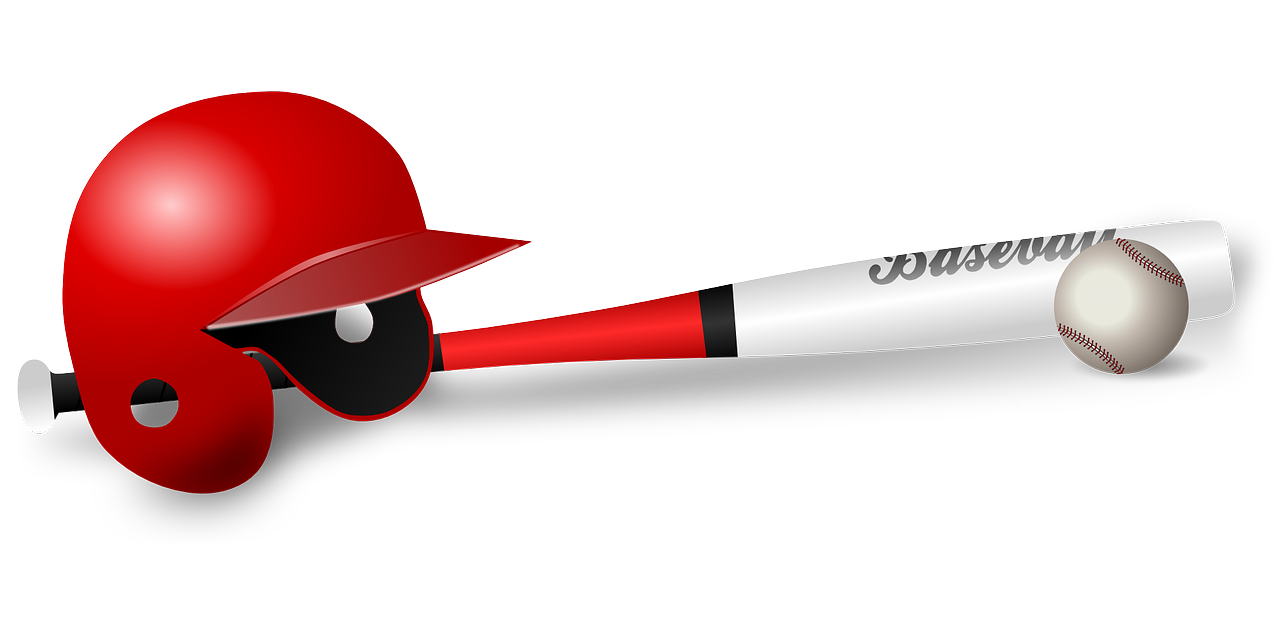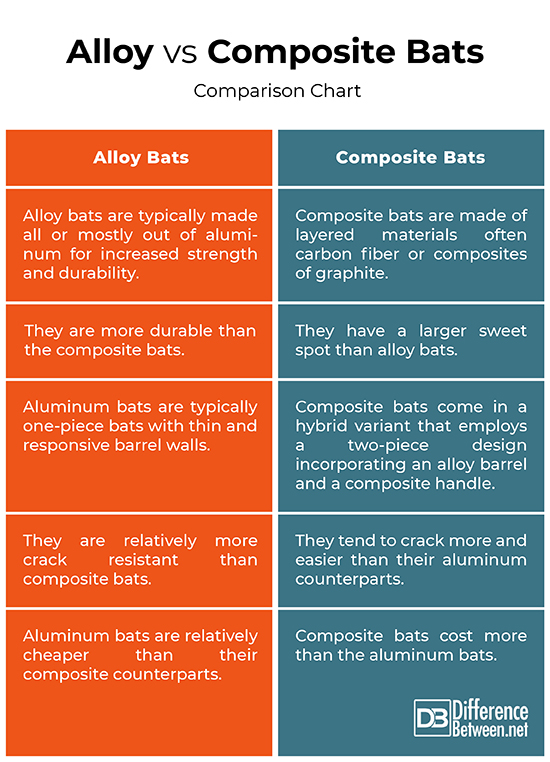Difference Between Alloy and Composite Bat
The design and technology of baseball bats has evolved over years, partly by engineering innovations and partly driven by marketing requirements to produce new, improved models almost every year. The most significant breakthrough in bat technology came in the 1960’s and early 1970’s, when aluminum bats made their way into baseball and softball, changing the games forever. In a very short period of time aluminum bats took over the game, which is still dominates. The evolution of aluminum baseball bats has paralleled the availability of lightweight aerospace alloys. They cost a lot more but their effectiveness and durability made them worth the cost. Meanwhile, bat manufacturers started working on more sophisticated composite bats made of wood and high-tech fibers which make them as durable as metal. Composite bats were originally introduced in the late 1990’s and are still in play. While alloy and composite bats are generally more elastic than the conventional wood bats, let’s see how the two stand up to each other in terms of performance among other factors.
What is Alloy Bat?
Alloy bats are typically made all or mostly out of lightweight aluminum and they are one-piece bats with thin and responsive barrel walls that don’t break because of its strength and rigidity. Aluminum bats were first introduced in the early 1970s but it wasn’t until the World War II that it made appearance. By 1969, aluminum bats made their way into softball. Little League baseball approved them in 1971, and the NCAA started using aluminum bats in 1975. In a short period of time, aluminum bats accounted for over 90 percent of the bat market. They quickly became the preferred choice of bat type in the amateur league games. The designs were improved significantly, which include addition of small amounts of copper scandium for increased strength. They were more forgiving too; a ball hit near the handle had a better chance of finding a hole in the infield. And the best part, the weight distribution can be altered by varying the shape and wall thickness.
What is Composite Bat?
Composite bats made their appearance starting in 2000 and were quick to gain popularity. Unlike aluminum bats, composite bats are made of triaxially braided graphite fibers that are layered upon over a rod and consolidated in a mold injected with thermoset epoxy resin. They have two barrels: an aluminum wall surrounding the inner core that is typically made out of a mixture of carbon fiber, graphite, and titanium. The carbon and the graphite composite materials are extremely lightweight and strong and are commonly used in the construction of the frames of tennis racquets, among other sporting equipment. The bats produce a sound much like that of wood and seem to perform more like wood, but without the tendency to break on impact. Because they are lighter, they can be lengthened without additional weight to the bat, allowing for a bigger sweet spot.
Difference between Alloy and Composite Bat
Material
– The service life and performance of a baseball bat is a function of its durability, which in turn, is directly influenced by the choice of material used in the construction of bats. Alloy bats are typically made all or mostly out of aluminum for increased strength and durability. One of the main advantages of aluminum is that the weight distribution can be altered by varying the shape and wall thickness. Composite bats, on the other hand, are made of carbon or graphite composite materials which are lightweight and strong, and are commonly used in the construction of the frames of tennis racquets.
Properties
– The main properties of aluminum bats with respect to durability is the alloy, heat treatment, forming process, and wall thickness variation. The idea behind alloy bats is that they are lighter which contributes directly to the bat speed and they don’t break at the handle. Most 34-inch alloy bats weigh around 29 to 30 ounces. For composite bats, the properties may be the choice of materials for the resin and fiber reinforcement and orientations of the respective layers. They have a large sweet spot and they tend to reduce the vibration on a mishit.
Hybrid Composite
– Aluminum bats are typically one-piece bats with thin and responsive barrel walls and which tend to lose less power upon impact and generate more power, making them a perfect choice of bat type among power hitters. Composite bats also come in a hybrid variant that employs a two-piece design incorporating an alloy barrel and a composite handle in order to reap the benefits of each. Hybrid composite bats have a large sweet spot with weight evenly distributed throughout the bat and leads to a smoother, faster swing.
Alloy vs. Composite Bats: Comparison Chart
Summary of Alloy vs. Composite Bats
Although, aluminum bats cost a lot more than the conventional wood bats but their effectiveness and durability made them worth the cost. Composite bats, on the other hand, are made of carbon or graphite composite materials which are lightweight and strong, but they tend to crack easier than aluminum bats. Although they cost more than their aluminum counterparts, they can be lengthened without adding any additional weight to the bat which allows for a larger sweet spot. Well, both aluminum and composite bats have their fair share of pros and cons.
- Difference Between Caucus and Primary - June 18, 2024
- Difference Between PPO and POS - May 30, 2024
- Difference Between RFID and NFC - May 28, 2024
Search DifferenceBetween.net :
Leave a Response
References :
[0]Image credit: https://pixabay.com/de/vectors/baseball-baseballschl%C3%A4ger-kugel-155990/
[1]Image credit: https://www.flickr.com/photos/pmbell64/5952882176/
[2]Allister, Mark. Women’s College Softball on the Rise. Jefferson, North Carolina: McFarland & Company, Inc., 2019. Print
[3]Cross, Rod. Physics of Baseball & Softball. Berlin, Germany: Springer, 2011. Print
[4]Moritz, Eckehard and Steve Haake. The Engineering of Sport 6 (Volume 1 Development for Sports). Berlin, Germany: Springer, 2011. Print



